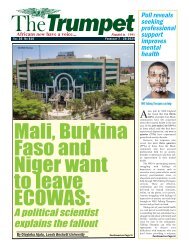The Trumpet Newspaper Issue 555 (October 6 - 19 2021)
Beaten and detained. Metropolitan Police celebrates black officers
Beaten and detained.
Metropolitan Police celebrates black officers
Create successful ePaper yourself
Turn your PDF publications into a flip-book with our unique Google optimized e-Paper software.
Page10 <strong>The</strong><strong>Trumpet</strong> OCTOBER 6 - <strong>19</strong> <strong>2021</strong><br />
Science<br />
Scientists discover why some<br />
individuals have stronger natural<br />
defences against SARS-COV-2<br />
Anew study has revealed key<br />
insights into the natural human<br />
antiviral defences against<br />
SARS-CoV-2, the virus that causes<br />
COVID-<strong>19</strong>.<br />
<strong>The</strong> research, published in the<br />
journal Science and led by a team of<br />
scientists at the MRC-University of<br />
Glasgow Centre for Virus Research,<br />
sheds new light on why some people<br />
are naturally more resistant to serious<br />
SARS-CoV-2 infection – and how, in<br />
the future, the coronavirus might<br />
overcome this resistance.<br />
COVID-<strong>19</strong> is spread from person to<br />
person after the virus, shed by an<br />
infected person, infects the cells of a<br />
new host. Once infected, our cells try to<br />
fight off the invading virus and<br />
scientists already know that this works<br />
better in some people, making their<br />
experience of the disease less severe.<br />
However, until now, that anti-viral<br />
response – and its effect on the virus<br />
SARS-CoV-2 – hasn’t been wellunderstood.<br />
In the study, the scientists reveal that<br />
some people have a version of a gene,<br />
called OAS1, that potently inhibits<br />
SARS-CoV-2.<br />
<strong>The</strong> study showed that, while some<br />
people can express a more protective<br />
‘prenylated’ version of the OAS1 gene,<br />
other people express a version of this<br />
gene which does not detect SARS-<br />
CoV-2.<br />
Inside cells, coronaviruses hide and<br />
replicate inside vesicles coated with<br />
Some individuals have stronger natural defences against SARS-COV-2..<br />
lipid (fat). Prenylation is the addition of<br />
a single molecule of lipid (fat) to a<br />
protein – and it’s this technical<br />
difference that allows prenylated OAS1<br />
to ‘seek out’ the invading virus and<br />
‘sound the alarm’.<br />
<strong>The</strong> study found that, in hospitalised<br />
patients, expression of a prenylated<br />
version of this gene was associated with<br />
protection from severe COVID-<strong>19</strong>,<br />
which suggests this antiviral defence is<br />
a major component of a protective<br />
antiviral response; and is likely to have<br />
offered protection to many people<br />
during the course of the pandemic.<br />
<strong>The</strong> study also found that<br />
hospitalized COVID-<strong>19</strong> patients with<br />
the ‘bad’ form of OAS1 had worse<br />
clinical outcomes compared to those<br />
who expressed the protective<br />
prenylated version of OAS1. Severe<br />
disease was significantly more frequent<br />
with ICU admission or death being<br />
approximately 1.6 times more likely in<br />
these patients.<br />
Interestingly, the researchers also<br />
found that, approximately 55 million<br />
years ago, there was a removal of this<br />
protective gene in horseshoe bats – the<br />
presumed source of SARS-CoV-2) – so<br />
therefore SARS-CoV-2 never had to<br />
adapt to evade this defence.<br />
As the protective prenylated OAS1<br />
gene is widespread in animals, the<br />
billions of people that lack this<br />
protective gene could make humans<br />
particularly vulnerable to the spill over<br />
of coronaviruses from horseshoe bats.<br />
Sam Wilson said: “We know viruses<br />
adapt, and even SARS-CoV-2 has<br />
likely adapted to replicate in the animal<br />
reservoir(s) in which it circulates.<br />
Cross-species transmission to humans<br />
exposed the virus SARS-CoV-2 to a<br />
new repertoire of antiviral defences,<br />
some of which SARS-CoV-2 may not<br />
know how to evade.<br />
“What our study shows us is that the<br />
coronavirus that caused the SARS<br />
outbreak in 2003 learned to evade<br />
prenylated OAS1. If SARS-CoV-2<br />
variants learn the same trick, they could<br />
be substantially more pathogenic and<br />
transmissible in unvaccinated<br />
populations. This reinforces the need to<br />
continually monitor the emergence of<br />
new SARS-CoV-2 variants.”<br />
<strong>The</strong> study, ‘A Prenylated dsRNA<br />
Sensor Protects Against Severe<br />
COVID-<strong>19</strong>,’ is published in Science.<br />
<strong>The</strong> study was predominantly funded<br />
by the Medical Research Council,<br />
Wellcome, and UKRI.<br />
A link to the study can be found<br />
here:<br />
https://www.science.org/doi/10.1126/s<br />
cience.abj3624<br />
STALLIONS AIR<br />
Ipanema Travel Ltd<br />
AFRICA FLIGHTS<br />
SPECIALISTS<br />
LAGOS fr £477<br />
(2 Bags)<br />
020 7580 5999<br />
07979 861 455<br />
Call AMIT / ALEX<br />
73 WELLS ST, W1T 3QG<br />
All Fares Seasonal<br />
ATOL 9179

















